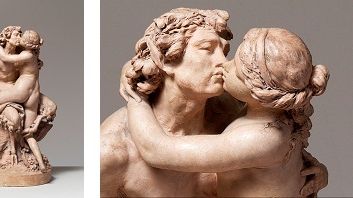
Press release -
Nationalmuseum acquires Clodion’s Satyr and Nymph
At an ordinary public auction this past April, Nationalmuseum
purchased a magnificent terracotta sculpture by French artist Claude
Michel, known as Clodion. The piece, thought to date from the 1780s,
depicts a satyr embracing a young nymph. Clodion’s superb attention to
detail and perfect balancing of the two figures makes this one of his
most significant works.
Claude Michel, known as Clodion, was two years the senior and a colleague of the Swedish sculptor Johan Tobias Sergel during his time in Rome. Clodion never completely abandoned the graceful rococo style. Not surprisingly, he was popular with collectors, but he was never elected to the Académie in his native France. The terracotta sculpture of a satyr embracing a nymph, purchased by Nationalmuseum at a public auction held by Stockholms Auktionsverk in April, typifies Clodion’s work in many respects. This piece, which probably dates from the 1780s, is a finished work rather than a prototype. Clodion produced these terracotta pieces for an eager market that could hardly wait for him to finish his works, since they were so popular. He produced several variations on the satyr and nymph theme, but the piece recently acquired by Nationalmuseum is one of the most thoroughly executed. The two figures, perfectly balanced in relation to each other, appear to be fashioned from a single piece of clay. Rather than powerful eroticism, the work exudes a gentle sensualism, which is most evident in the tentative kiss being exchanged between the couple. Clodion makes elegant play with the contrast between the plastic smoothness of the skin and the graphic nature of the nymph’s hair, carved into the clay while it was still wet.
On account of its sensual subject matter, in 1990 the grouping ended up in a private Swedish erotica collection. At different points in its life it had belonged to Henri Rochefort, a prominent French politician, and Jacques Doucet, a legendary art collector, whose collection (auctioned off piecemeal in 1912) included Picasso’s les Demoiselles d’Avignon. A counterpart to Clodion’s Satyr and Nymph can be seen in the Metropolitan Museum of Art in New York. The version now acquired by Nationalmuseum was long believed to be lost.
The acquisition was made possible by a generous donation from the Sophia Giescke Foundation. The Nationalmuseum has no funds of its own with which to acquire art and design, and so relies on gifts and financial support from private foundations and funds to expand its collection.
Further information
Magnus Olausson, Director of Collections and the Swedish Portrait Gallery, mon@nationalmuseum.se, +46 8 5195 4371
Hanna Tottmar, Press Officer, htr@nationalmuseum.se, +46 8 5195 4390, +46 767 234632
Categories

